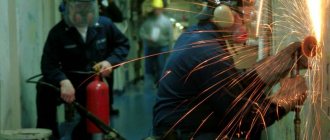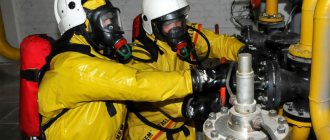I am often asked the question: “How to properly issue a work permit for work at height and all related documents?” Therefore, I will analyze this issue in detail in accordance with Order of the Ministry of Labor No. 782n.
As I said in a previous article about working at height, the risk involved in this activity is very high, and ensuring employee safety is your first priority. At the same time, we must not forget about the documents, because the absence or incorrect execution of one of them can expose the employer to administrative liability.
Therefore, when performing dangerous work, every detail is important; in this article we will analyze in detail when it is necessary to issue a work permit, who should do it and - most importantly - how to fill it out “without a hitch.”
I ask you to rate the material and leave feedback in the comments, and you can also ask questions there that were not discussed in this article. This will be useful not only to you and me, but also to other visitors.
What applies to working at heights?
To begin with, it makes sense to define what constitutes work at height in accordance with POTRV. When most people mention height, they probably immediately think of professions related to construction or exterior repairs, industrial mountaineering and other activities in which the worker has to climb quite high, risking his life. However, this definition of the Rules includes not only steeplejack work. What work activities are legally classified as work at height?
- Labor functions, during the performance of which there is a risk of falling from a height of 1.8 m.
- Performing work that is carried out above the surface of water, protruding objects or machines and other mechanisms, if the worker is at risk of falling from a height of less than 1.8 m.
- Work that is carried out at a distance closer than 2 m from unfenced (or with a fence of 1.1 m and below) surface differences of more than 1.8 m in height.
- During the work process, a vertical ladder is ascended or descended to a height of more than 5 m, while the angle of inclination of the ladder relative to the horizontal surface is 75˚ or more.
Thus, work at height includes not only pulling power lines, industrial mountaineering or the work of a high-altitude installer, but also interior finishing work, washing windows, pruning trees and much more.
Who can do this type of work
Employees who have access to this type of activity and a level of professional qualifications corresponding to the nature of the work performed have the right to carry out work at height. The employee is required to confirm his qualifications with a document (diploma, certificate, etc.) of qualifications and/or professional education.
An employee has the right to obtain permission to work at height after successfully completing training in the field of occupational safety and health. This:
- training in labor safety requirements followed by testing of knowledge;
- training course in safe techniques and methods for carrying out this work;
- labor safety briefings conducted in accordance with the requirements of labor legislation.
In addition, only adults (18 years of age and older) and those who have passed a medical examination may be allowed to work at heights.
Based on the results of the training, employees who meet all of the above requirements receive a certificate indicating the group of admission to work at height. Subsequently, workers carrying out this type of activity are required to undergo periodic training (retraining) in a timely manner in safe methods of performing work at height, depending on the work safety group.
Who can work at heights
In order to receive a work permit form for work at height, an employee must meet a number of requirements:
- age 18 years or more;
- absence of medical contraindications (based on the results of mandatory preliminary and periodic medical examinations);
- availability of qualifications corresponding to the formats of the processes performed (confirmed by documents on professional education);
- the fact of completing training on safety at heights, resulting in successful passing of the exam and receipt of a certificate;
- more than one year of experience (if appointed responsible for the internship).
Procedure for organizing work at height
The beginning of work at height must be preceded by several mandatory stages of preparation and organization:
- Drawing up and approval of a list of work at heights performed by company employees at non-stationary locations.
- Development, coordination and implementation of a work plan (hereinafter referred to as WWP) at a high level in accordance with the list approved by the organization.
- For work carried out in the security zone of communications or buildings, it is required to obtain official permission from the owner of the building or communications.
- Instruction on work at height for members of the work team specified in the work permit (conducted by ORR).
Who has the right to issue an employee a work permit?
The permit must be issued by an employee who has a higher qualification: the third group of clearance for safety of work at height. Also, the head of the company must draw up an order approving this employee for the formation of a work permit. This employee, in addition, may be responsible for the execution of work and be included in the list of team workers.
An employee who fills out and issues permits (as stated in paragraph 28 of Order No. 155n) is obliged to:
- approve actions that are needed to ensure the safety of workers;
- appoint employees who will be responsible for the management and execution of these actions;
- identify the number of permits;
- determine a list of tasks, equipment necessary for work, specific locations for work;
- hand over 2 copies of the work order to the production process manager and indicate this fact in the journal for issuing work permits;
- familiarize the manager with the peculiarities of the place of work;
- control the implementation of safety work specified in the work order;
- accept the finally completed and closed work permit after completion of the work and transfer its data to the accounting journal.
Drawing up the PPR
To draw it up, the organization appoints a person responsible for approving the PPR (an official of the organization). The PPR contains a detailed informative description of all stages of work, including:
- Means and methods for ensuring the health and life safety of employees performing work at height: means of protection against harmful production factors, a list of safety, fencing, protective devices and mechanisms, etc.
- Methods and descriptions of devices for lifting people and loads, auxiliary scaffolding equipment (scaffolding, ladders, cables, etc.), methods for removing (removing) waste and debris.
- The means of communication, lighting, alarm systems, fire safety and sanitary facilities used, technological compliance of mechanisms and equipment, etc.
- Other measures designed to ensure a safe work process.
It is important! The list of security measures in the permit must correspond to the measures specified in the PPR. It is strictly prohibited to make changes to the measures to ensure the safety of high-altitude work, which are specified in the work permit and the work permit.
Who can do them
Performers of tasks at height must meet certain criteria:
- these can only be adult citizens;
- they have no medical contraindications (according to preliminary and periodic medical examinations);
- they have undergone the necessary instructions, trained and have special certificates; additional knowledge tests are carried out for them at least once a year;
- have at least 1 year of experience if the employee is appointed responsible for execution (2nd and 3rd clearance groups).
Who can issue a permit?
An authorization order—an authorization order on a special form—confirms that the workers (labor team) have received the employer’s direction to perform specific work. Who issues permits for high-altitude work in the employer's organization? To complete and issue it, an official must be appointed from among the organization’s managers or specialists (most often, a labor protection engineer). The assignment of this function must be secured by order (instruction) of the head of the organization.
In addition, to organize the safe performance of work at height, the organization must be assigned:
- Responsible work manager (hereinafter referred to as ORR), also from among the specialists or managers of the organization.
- Responsible producer (performer) of work. This may be an employee holding the position of a foreman, a unit manager, or a highly qualified worker in the organization.
All appointed officials are required to undergo special training.
Responsibility of an official
According to the Rules, persons authorized to issue permits are responsible for:
- Correct and timely completion and issuance, as well as further recording and storage of closed permit forms.
- Approval of the composition of the work team and appointment of persons responsible for safety.
- Carrying out measures to ensure the safety of work specified in the permit, as well as monitoring compliance with and implementation of safety measures specified in the permit.
Sample of filling out a height permit
This example will help you fill out the outfit correctly.
Be sure to describe in detail the composition of the security system in your work permit. It is advisable to indicate GOST for each element of the system. In the same order, the composition of the systems will be described in the work plan. It also describes in detail how to use security systems.
| Sample filling |
| Work permit form |
Filling rules
The general rules for filling out a work permit for high-altitude work are as follows:
- Accounting for high-altitude work carried out with the issuance of a work permit is kept in a separate production journal (Journal of work accounting for work permits).
- The work order is drawn up in at least two copies, both issued under the signature of the ORR, with an entry made in the SD Journal.
- All entries are made on the work permit form for high-altitude work in legible handwriting, without crossing out or corrections.
- Filling is done exclusively with ink writing. It is unacceptable to use a pencil for this.
- The procedure for assigning a serial number to a permit is established by an administrative document (order, regulation, etc.) of the head of the organization.
- If there is not enough space to fill out in the lines of one form, you can hem (glue) an addition to the permit. In this case, on the main form you should make a clarifying inscription “See. additional form." The second sheet of the form is assigned the same serial registration number as the main form.
- When entering information about employees of the organization, you should indicate their last names (in full) and initials.
- The dates on the permit form are entered in numbers, for example “11/04/2017”.
Work log for work permits
When working under a work permit, only the initial permit for work is recorded in the log book of work under the work permit. The log must indicate:
- work permit number
- place and name of work
- date and time of start and end of work
(columns 1, 2, 6 and 7).
The magazine must be numbered, laced and sealed with the organization's seal. The shelf life of the journal is one month from the date of registration in column 7 of the complete completion of work according to the last work permit registered in the journal.
| Magazine blank |
The recommended sample journal may be supplemented or modified.
How to fill out an outfit
What information should a work permit for high-altitude work contain (see below for a sample of the form)? Currently, there is no strictly prescribed form for the work permit form for high-altitude work. The form in force at the enterprise (organization) is approved by order of the manager and must contain items required for entering the information prescribed by the Rules. Thus, the registration of a work permit is carried out as follows:
- The serial registration number is entered into the table of contents in accordance with the numbering order approved by the organization.
- In the lines “Enterprise” and “Division” the legal name of the organization and the name of the division without abbreviations are entered.
- The surnames and initials of the ORR and the responsible executor are indicated.
- The names of the team of workers indicating their admission. If the composition of the team is changed in the future, the ORR or the responsible executive must record this in the work permit by entering the surname and initials of the new employee in the form in the “Separate instructions” line.
- The place where the work will be carried out.
- Contents (name) of all work performed.
- Duration (period) of work (specific start time and end time).
- List of equipment required to ensure the performance of work at height.
- Conditions: lists all possible harmful and dangerous production factors that may arise during the performance of these types of high-altitude work.
- Measures to ensure the safety of high-altitude work: provision of personal protective equipment, special equipment, installation of protective fencing, etc.
- Information about the preliminary inspection of the place where high-altitude work is carried out: date, full name, position held and personal signature of the employee who issued the permit, as well as the person in charge.
- In the line “Issued a work permit” the surname and initials and position of the authorized person for issuing this document are indicated. Certified by the personal signature of the person who issued the paper.
- The “Instruction” section is filled out: the surname and initials of the ORR who conducted the instruction for the brigade workers, data (full name, position) and personal signature of the workers who received the instruction.
- Additionally, if several shifts are worked, a daily permit is issued.
- Upon completion of high-altitude work, the work permit is closed by filling out the line “Completion of work,” which indicates the date and time of completion of high-altitude work and information about checking equipment, tools, and other things.
How to fill out the form correctly
The form and form of the document in question is regulated by federal legislation, in particular by Order No. 155.
Work permit for work in electrical installations in production
The filling procedure does not entail any difficulties and is as follows:
- Initially, you need to put a number on the document in strict accordance with the registration details in the journal.
- After this, information is indicated: about the company, structural unit, employee (who will carry out the order of the authorities), the date of issue of the document and the validity period, the full initials of the appointed responsible specialist, for what work the work order was provided (it is recommended to use a list).
- Without exception, all employees from the team who will be engaged in a specific type of work must be listed in a specially designed table. In addition, do not forget that they must provide personal signatures in order to confirm that they have listened to certain instructions.
- Information is entered regarding the address at which the work and assigned tasks will be performed.
- Next, you need to write down the established conditions with detailed information about the work, temperature conditions and other details.
- Existing risks and a list of hazards that may arise at height.
- Specific time and date for the start and end of work.
- The provided security systems that are used during the execution of the order, and the data must be indicated in the fullest possible volume; any abbreviations are unacceptable.
- A list of guidelines, prescriptions and instructions that may be useful for the team. Will the use of assistive tools be allowed?
- Information about the responsible official with comprehensive information about the timing of the execution of the received order. Corrections and adjustments after approval are unacceptable according to Russian legislation.
- At the next stage, you need to provide information about the specialist who issued the work order with the date displayed.
On a note! The remaining items and lines must be filled out by the responsible head of the structural unit. They should contain information regarding the briefings carried out, the procedure for preparing the workplace, and possible adjustments to the composition of the team.
Upon completion of the work, it is necessary to fill out the last paragraph of the access order with the signature of the person in charge.
You can issue a new document after canceling the previous one.
The permit for high-altitude work, a sample of which can be found on the Internet, is recommended to be used by all responsible persons in order to avoid mistakes with the ensuing consequences.
Validity period, extension
The permit document is issued for the period necessary to carry out the planned high-altitude work, but no more than 15 calendar days from the start of their implementation. The validity period can be extended for up to 15 days, but only once.
If there is a break in the process of carrying out high-altitude work, then, regardless of the reason, the permit remains valid. In some cases, the ORR may decide to prematurely terminate the validity of the work permit and stop the work under it if, in the process of performing work at height, unavoidable production factors have arisen that pose a danger to the health or life of workers.
Storage
Canceled documents (permits for which high-altitude work has been permanently terminated or completed) are stored for 30 days, after which the forms are destroyed in the prescribed manner. An exception is made for permits if an industrial accident occurs while working on them at height. Such clearance orders are filed in the archive along with materials on the internal investigation.
Organization of high-altitude work without a work permit
The rules provide for exceptional cases when workers can begin specific work at height without a formalized work permit. Such situations include:
- eliminating a threat to the life of an employee;
- warning (prevention) of an accident;
- liquidation of the consequences of various natural disasters or industrial accidents.
It is worth immediately clarifying that the exceptions in the Rules apply only to work that is carried out within 24 hours. If after this period the need for high-altitude work remains, a work permit for high-altitude work must be issued.
Violation of the rules for carrying out work at heights
Compliance with safety rules at height
The Labor Inspectorate of the State Labor Inspectorate monitors it very strictly. If there are violations, the State Tax Inspectorate may impose serious penalties on the company. Firstly, according to the Code of Administrative Offenses of the Russian Federation, the employer faces a fine of up to 130 thousand rubles per employee. Secondly, if serious violations are detected, the activities of the enterprise will be suspended until the violations are corrected. Thirdly, if an accident occurs at an enterprise where labor safety requirements were violated, it is likely that a criminal case will be initiated. These unpleasant consequences will primarily threaten the company’s management and its founders. Fourthly, we are talking about the health and life of workers. Being the culprit in the disability, or even worse, the death of an employee, it will be difficult to sleep peacefully.
Remember! Failure to comply with the Rules due to ignorance does not exempt you from liability.
To avoid troubles at the enterprise, it is necessary to carry out a set of measures. Learn what the Comprehensive Work at Height Safety System consists of.








